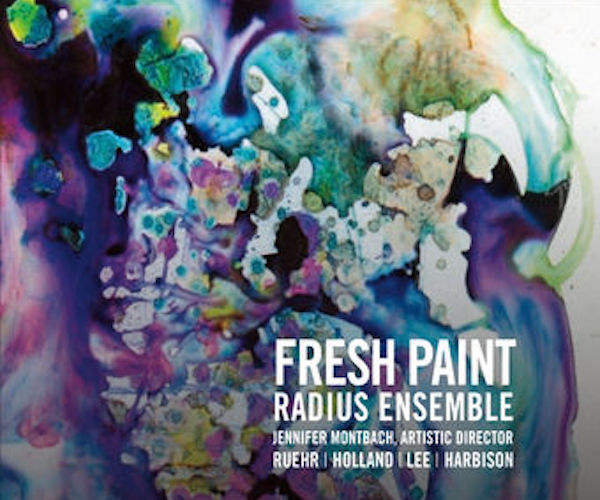Classical Music CD Review: Radius Ensemble’s Refreshing “Fresh Paint”
The disc offers a rewarding look at the work of four local composers and also showcases the members of Radius Ensemble in a warm, winning light.

By Jonathan Blumhofer
It’s one thing for an ensemble to build its whole season around a series of new pieces commissioned by members of the group. It’s quite another to then commit the set of them to disc, thereby preserving and encouraging their future dissemination. But that’s just what the Cambridge-based Radius Ensemble did this past year. The group’s four-concert 2015-16 Longy season featured a world premiere on each program: one each from Elena Ruehr, Jonathan Bailey Holland, Eun Young Lee, and John Harbison. In May, they went into the studio and committed each piece to disc. The resulting album, Fresh Paint, offers a rewarding look at the work of four local composers and also showcases the members of Radius in a warm, winning light.
The first track, Ruehr’s Quetzal Garden, is a vigorous, engaging chamber concerto for flute and strings. Evoking flute music from around the world, it opens with a propulsive, dance-like section. Gradually, the music slows down and a new movement emerges, this one marked at the beginning by a call-and-response duet between flute and cello over sustained string chords. The third part is, like the first, balletic but a bit more relaxed and refined, with echoes of Debussy and Ravel alluding to its French influence. Radius’ performance is supremely inhabited – there’s a confidence to the playing here that suggests a serious comfort level with all of the music’s ins and outs – and highlighted by Sarah Brady’s colorfully agile account of the involved flute part.
In contrast, Holland’s Synchrony is the disc’s most politically-charged score, peppered with excerpts from speeches by President Barack Obama and Cicely Tyson plus recordings of the arrests of Eric Garner and Sandra Bland. The music, itself, is, as the composer describes it, “about duality,” musical and otherwise. Appropriately, there’s a good deal of variety between instrumental combinations, melodic gestures, and textures packed into its seven-plus-minute duration. Largely elegiac in character, Synchrony is an affecting piece, moving, direct, and – given what we know now about outcomes of Garner’s and Bland’s arrests – a heartbreaking one, too. I couldn’t help but wish that it had gone on for another seven minutes or so, given its potent content; even so, it’s a strong introduction to Holland’s work and is sumptuously played here by oboist Jennifer Montbach, bassoonist Adrian Morejon, violinist Gabriela Diaz, cellist Miriam Bolkosky, and pianist Sarah Bob.
Lee’s *12* goes in more of a whimsical direction, drawing musical portraits of some of the composer’s friends and family members with reference to their Zodiac signs. It also involves a technological element which, at its premiere, was triggered by smart phone-wielding members of the audience. On this recording, that aspect of the piece is absent – or so discreet as to seem like it’s not there. But that allows one to focus on the details of the music and, in that, there are more than a few inventive episodes. Highlights include a burbling duet for oboe and bassoon in “Gemini,” a furiously driving dialogue between flute and violin in “Cancer,” extended flute techniques galore in “Scorpio” (again, brilliantly played by Brady), delicately shimmering writing for strings in “Sagittarius,” and a weird jungle of low wind and horn sounds in “Capricorn.” Striking as its individual moments can be, though, *12* is a piece that, for me, never really added up to more than the sum of its parts: there’s too much going on – and in different directions – to tie it all together.
Harbison’s Nine Rasas, on the other hand, does exactly the opposite. I was in the audience at its premiere in April and the memory of that performance – at the time, I wrote that it was a “haunting…emotionally direct piece” – is only expanded upon in the superb recording clarinetist Eran Egozy, violist Noriko Futagami, and pianist Yukiko Ueno Egozy turn in here.
Inspired by the legacy of the Indian king, Ibrahim Adil Shah II, the Rasas are, somewhat like the Holland, a study in doublets, these relating to various emotional states. Thus, the movements are titled “Attraction/Desire,” “Play/Mirth,” “Fury/Obsession,” “Regret/Remorse,” and so on. Harbison’s music in them is a bit of a stylistic hodgepodge, some of it driven by jazz, some highly chromatic, some plainly diatonic, all of it personable and expressively direct. Indeed, in the finale “Tranquility/Repose,” Harbison’s written two of the most haunting minutes of music to yet come from his pen. As a piece, the Rasas are a triumph and the present recording of them excellent: the perfect conclusion to a meaningful, revealing, and enjoyable season and, now, new album.
Jonathan Blumhofer is a composer and violist who has been active in the greater Boston area since 2004. His music has received numerous awards and been performed by various ensembles, including the American Composers Orchestra, Kiev Philharmonic, Camerata Chicago, Xanthos Ensemble, and Juventas New Music Group. Since receiving his doctorate from Boston University in 2010, Jon has taught at Clark University, Worcester Polytechnic Institute, and online for the University of Phoenix, in addition to writing music criticism for the Worcester Telegram & Gazette.
Tagged: Elena Ruehr, Eun Young Lee, Fresh Paint, John Harbison, Jonathan Bailey Holland
